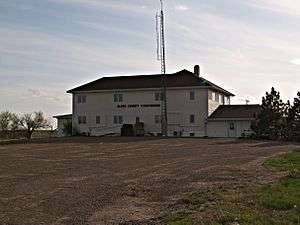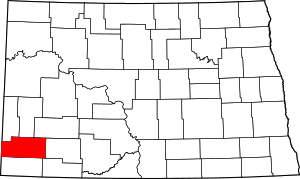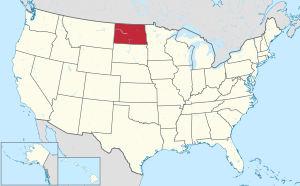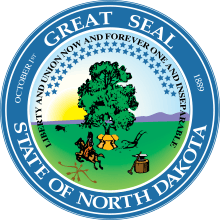Slope County, North Dakota
Slope County is a county in the U.S. state of North Dakota. As of the 2010 United States Census, the population was 727,[1] making it the least populous county in North Dakota and the 20th-least populous county in the United States. The county seat is Amidon.[2]
Slope County | |
|---|---|
 Former Slope County Courthouse in Amidon | |
 Location within the U.S. state of North Dakota | |
 North Dakota's location within the U.S. | |
| Coordinates: 46°27′N 103°28′W | |
| Country | |
| State | |
| Founded | November 3, 1914 January 14, 1915 (organized) |
| Seat | Amidon |
| Largest city | Marmarth |
| Area | |
| • Total | 1,219 sq mi (3,160 km2) |
| • Land | 1,215 sq mi (3,150 km2) |
| • Water | 4.2 sq mi (11 km2) 0.3% |
| Population (2010) | |
| • Total | 727 |
| • Estimate (2019) | 750 |
| • Density | 0.60/sq mi (0.23/km2) |
| Time zone | UTC−7 (Mountain) |
| • Summer (DST) | UTC−6 (MDT) |
| Congressional district | At-large |
| Website | www |
History
The vote to create Slope County, by partitioning the lower portion of Billings, was held on November 3, 1914. This was the final (as of 2019) alteration to that once-large Dakota county, as Bowman had been partitioned off in 1883, and Golden Valley was split off in 1910. The unorganized Slope County was not attached to another county for administrative or judicial purposes during the interregnum; on January 14, 1915 the county organization was effected.[3][4][5] The name refers to the Missouri Slope, a geographical feature that is also a popular designation for western North Dakota, particularly the area west of the Missouri River.
Geography
Slope County lies on the lower west side of North Dakota. Its west boundary line abuts the east boundary line of the state of Montana. The Little Missouri River enters the county's north boundary line at its midpoint, and flows southwestward through Three V Crossing, and then southward through the county's western portion. Cedar Creek drains the SE portion of the county, flowing southerly into Bowman County.
Slope County terrain consists of semi-arid rough hills and gullies interspersed with lower hills, part of which is dedicated to agriculture.[6] The terrain slopes to the east and south; its highest area (except for isolated prominences, such as White Butte) is its NW corner, at 3,104' (945m) ASL.[7] The county has a total area of 1,219 square miles (3,160 km2), of which 1,215 square miles (3,150 km2) is land and 4.2 square miles (11 km2) (0.3%) is water.[8]
White Butte, the highest natural point in North Dakota at an elevation of 3506 ft (1062 m), is in southeast Slope County.
Major highways


National protected areas
Adjacent counties
- Billings County - north
- Stark County - northeast
- Hettinger County - east
- Adams County - southeast
- Bowman County - south
- Fallon County, Montana - west
- Golden Valley County - northwest
Lakes[6]
- Cedar Lake
- White Lake
Demographics
| Historical population | |||
|---|---|---|---|
| Census | Pop. | %± | |
| 1920 | 4,940 | — | |
| 1930 | 4,150 | −16.0% | |
| 1940 | 2,932 | −29.3% | |
| 1950 | 2,315 | −21.0% | |
| 1960 | 1,893 | −18.2% | |
| 1970 | 1,484 | −21.6% | |
| 1980 | 1,157 | −22.0% | |
| 1990 | 907 | −21.6% | |
| 2000 | 767 | −15.4% | |
| 2010 | 727 | −5.2% | |
| Est. 2019 | 750 | [9] | 3.2% |
| US Decennial Census[10] 1790-1960[11] 1900-1990[12] 1990-2000[13] 2010-2019[1] | |||
2000 census
As of the 2000 United States Census, there were 767 people, 313 households, and 222 families in the county. The population density was 0.63 people per square mile (0.14/km²). There were 451 housing units at an average density of 0.37 per square mile (0.24/km²). The racial makeup of the county was 99.84% White, 0.08% Native American, and 0.13% from two or more races. 0.08% of the population were Hispanic or Latino of any race. Slope County has the highest percentage white population of any U.S. county. 46.9% were of German, 15.2% Norwegian, 8.1% American, 7.4% English and 7.2% Swedish ancestry.
There were 313 households out of which 30.0% had children under the age of 18 living with them, 64.5% were married couples living together, 3.8% had a female householder with no husband present, and 28.8% were non-families. 27.2% of all households were made up of individuals and 10.5% had someone living alone who was 65 years of age or older. The average household size was 2.45 and the average family size was 2.96.
The county population contained 25.3% under the age of 18, 4.2% from 18 to 24, 25.0% from 25 to 44, 27.6% from 45 to 64, and 17.9% who were 65 years of age or older. The median age was 42 years. For every 100 females there were 116.7 males. For every 100 females age 18 and over, there were 117.0 males.
The median income for a household in the county was $24,667, and the median income for a family was $26,058. Males had a median income of $20,000 versus $12,115 for females. The per capita income for the county was $14,513. About 15.40% of families and 16.90% of the population were below the poverty line, including 16.30% of those under age 18 and 8.00% of those age 65 or over.
2010 census
As of the 2010 census, there were 727 people, 326 households, and 224 families in the county.[14] The population density was 0.60/sqmi (0.23/km²). There were 436 housing units at an average density of 0.36/sqmi (0.14/km²).[15] The racial makeup of the county was 97.5% white, 2.2% American Indian, 0.0% from other races, and 0.3% from two or more races. Those of Hispanic or Latino origin made up 1.7% of the population.[14] In terms of ancestry, 53.9% were of German, 30.7% Norwegian, 9.9% English, 7.4% Swedish, 5.5% Polish and 2.8% American ancestry.<ref">"Selected Social Characteristics in the US – 2006-2010 American Community Survey 5-Year Estimates". US Census Bureau. Archived from the original on February 13, 2020. Retrieved April 3, 2016.</ref>
Of the 326 households, 22.4% had children under the age of 18 living with them, 60.7% were married couples living together, 4.9% had a female householder with no husband present, 31.3% were non-families, and 29.4% of all households were made up of individuals. The average household size was 2.23 and the average family size was 2.74. The median age was 49.2 years.[14]
The median income for a household in the county was $43,625 and the median income for a family was $55,833. Males had a median income of $36,458 versus $31,172 for females. The per capita income for the county was $24,824. About 6.8% of families and 10.5% of the population were below the poverty line, including 9.3% of those under age 18 and 11.7% of those age 65 or over.[16]
Politics
Slope County voters have traditionally voted Republican. In no national election since 1964 has the county selected the Democratic Party candidate (as of 2016).
| Year | Republican | Democratic | Third parties |
|---|---|---|---|
| 2016 | 84.2% 362 | 10.0% 43 | 5.8% 25 |
| 2012 | 78.0% 341 | 19.0% 83 | 3.0% 13 |
| 2008 | 72.3% 297 | 25.8% 106 | 2.0% 8 |
| 2004 | 77.6% 335 | 20.6% 89 | 1.9% 8 |
| 2000 | 71.5% 316 | 19.2% 85 | 9.3% 41 |
| 1996 | 58.4% 260 | 27.6% 123 | 13.9% 62 |
| 1992 | 42.2% 226 | 27.1% 145 | 30.7% 164 |
| 1988 | 59.4% 315 | 38.1% 202 | 2.5% 13 |
| 1984 | 69.3% 419 | 28.8% 174 | 2.0% 12 |
| 1980 | 71.4% 462 | 19.8% 128 | 8.8% 57 |
| 1976 | 48.9% 355 | 47.8% 347 | 3.3% 24 |
| 1972 | 59.9% 413 | 36.1% 249 | 4.1% 28 |
| 1968 | 55.6% 379 | 34.9% 238 | 9.5% 65 |
| 1964 | 43.0% 329 | 57.0% 436 | |
| 1960 | 52.4% 475 | 47.6% 431 | |
| 1956 | 52.0% 433 | 47.7% 397 | 0.4% 3 |
| 1952 | 69.4% 682 | 29.5% 290 | 1.1% 11 |
| 1948 | 50.5% 447 | 43.8% 388 | 5.7% 50 |
| 1944 | 49.4% 434 | 50.0% 439 | 0.6% 5 |
| 1940 | 57.6% 801 | 42.1% 585 | 0.4% 5 |
| 1936 | 23.3% 331 | 63.1% 896 | 13.7% 194 |
| 1932 | 27.8% 461 | 68.4% 1,136 | 3.8% 63 |
| 1928 | 60.9% 873 | 37.8% 542 | 1.3% 19 |
| 1924 | 39.1% 616 | 3.0% 47 | 57.9% 913 |
| 1920 | 76.6% 1,143 | 15.7% 235 | 7.7% 115 |
| 1916 | 34.8% 516 | 58.5% 867 | 6.6% 98 |
Gallery
 US Highway 12 bridge over the Little Missouri River
US Highway 12 bridge over the Little Missouri River Three V Crossing across the Little Missouri River
Three V Crossing across the Little Missouri River Old house
Old house Pierce Congregational Cemetery in Woodberry Township
Pierce Congregational Cemetery in Woodberry Township
References
- Specific
- "State & County QuickFacts". United States Census Bureau. Retrieved November 1, 2013.
- "Find a County". National Association of Counties. Retrieved June 7, 2011.
- "Slope County, North Dakota". North Dakota GenWeb Project. Retrieved September 14, 2012.
- "County History". Official Portal for North Dakota State Government. Archived from the original on February 2, 2015. Retrieved May 4, 2011.
- "Dakota Territory, South Dakota, and North Dakota: Individual County Chronologies". Dakota Territory Atlas of Historical County Boundaries. The Newberry Library. 2006. Retrieved February 1, 2015.
- Slope County ND Google Maps (accessed February 21, 2019)
- ""Find an Altitude/Slope County ND" Google Maps (accessed February 21, 2019)". Archived from the original on May 21, 2019. Retrieved February 21, 2019.
- "2010 Census Gazetteer Files". US Census Bureau. August 22, 2012. Archived from the original on January 29, 2015. Retrieved February 1, 2015.
- "Population and Housing Unit Estimates". Retrieved April 6, 2020.
- "US Decennial Census". US Census Bureau. Retrieved February 1, 2015.
- "Historical Census Browser". University of Virginia Library. Retrieved February 1, 2015.
- Forstall, Richard L., ed. (April 20, 1995). "Population of Counties by Decennial Census: 1900 to 1990". US Census Bureau. Retrieved February 1, 2015.
- "Census 2000 PHC-T-4. Ranking Tables for Counties: 1990 and 2000" (PDF). US Census Bureau. April 2, 2001. Retrieved February 1, 2015.
- "Profile of General Population and Housing Characteristics: 2010 Demographic Profile Data". US Census Bureau. Archived from the original on February 13, 2020. Retrieved April 3, 2016.
- "Population, Housing Units, Area, and Density: 2010 - County". US Census Bureau. Archived from the original on February 13, 2020. Retrieved April 3, 2016.
- "Selected Economic Characteristics – 2006-2010 American Community Survey 5-Year Estimates". US Census Bureau. Archived from the original on February 13, 2020. Retrieved April 3, 2016.
- Leip, David. "Atlas of US Presidential Elections". uselectionatlas.org. Retrieved April 13, 2018.
- General
- "Slope Saga", Slope Saga Committee, 1976, Pioneer Print, Bowman County Pioneer
External links
| Wikimedia Commons has media related to Slope County, North Dakota. |
